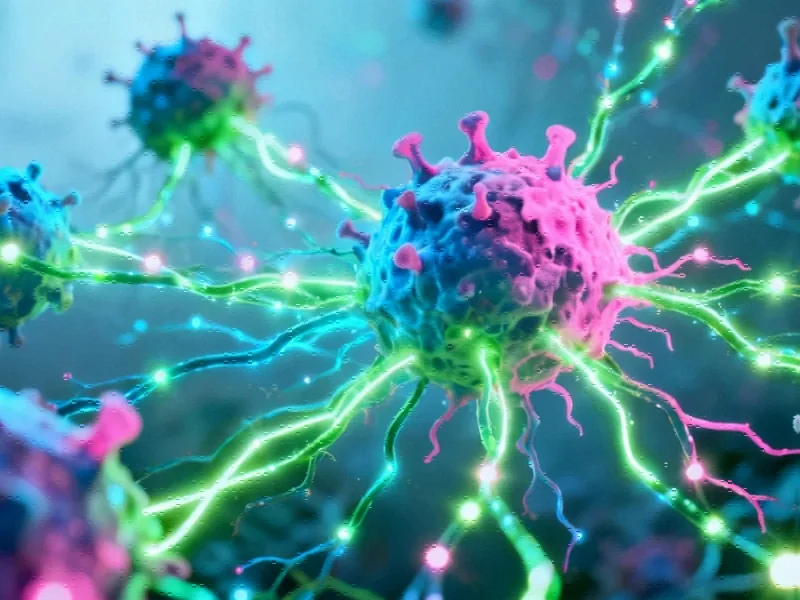The Hidden Language of Protein Modifications in Cancer
Cancer cells possess a remarkable ability to adapt and survive even the most aggressive chemotherapy treatments. This chemoresistance remains one of the most significant challenges in oncology, particularly in breast cancer where recurrence often follows initial treatment success. Recent research has uncovered that post-translational modifications, specifically lysine succinylation, play a crucial role in this adaptive process. These chemical modifications act as molecular switches that can dramatically alter protein function and cellular behavior in response to therapeutic stress.
The landscape of cancer research has been transformed by discoveries around metabolic reprogramming and epigenetic regulation. As scientists investigate these complex mechanisms, they’re uncovering how cancer cells manipulate their own biochemistry to evade treatment. This understanding is driving related innovations in both diagnostic approaches and therapeutic development.
Mapping the Succinylome: A Systematic Approach
In a groundbreaking study published in Communications Biology, researchers employed sophisticated proteomic techniques to map the “succinylome” – the complete set of succinylated proteins – in cancer cells exposed to chemotherapeutic agents. Using etoposide (ETOP) to induce DNA damage in U2OS cells, the team identified 4,354 lysine succinylation sites across 1,259 proteins. The quantitative analysis revealed dramatic changes, with 744 sites significantly upregulated and 242 downregulated following treatment.
The subcellular distribution told an even more compelling story. Among upregulated succinylated proteins, a striking 40.8% localized to mitochondria – the cellular powerhouses that have increasingly been recognized as key players in cancer progression. This mitochondrial enrichment suggests that succinylation modifications may be directly influencing the metabolic adaptations that enable cancer cells to withstand chemotherapy.
Metabolic Master Regulators: The NADPH Connection
Further analysis revealed that succinylated proteins were predominantly involved in core metabolic processes, including pyruvate metabolism, the TCA cycle, and glycogen regulation. This functional enrichment pointed researchers toward NADPH-metabolizing enzymes as potential key regulators of chemoresistance. NADPH serves as a critical redox currency in cells, helping maintain oxidative balance and providing reducing power for biosynthesis.
The investigation narrowed to specific enzymes, with MTHFD2 emerging as a particularly interesting candidate. This mitochondrial enzyme, which had not previously been known to undergo succinylation, showed dynamic modification changes following ETOP treatment. The discovery of MTHFD2 succinylation represents a significant advancement in our understanding of metabolic regulation in cancer cells and opens new avenues for therapeutic intervention.
Pinpointing the Molecular Switch: K44 Succinylation
Through meticulous site-mapping experiments, researchers identified lysine 44 (K44) as the primary succinylation site on MTHFD2. Creating arginine substitution mutants allowed the team to mimic a desuccinylated state, confirming that the K44R mutant displayed significantly reduced succinylation levels. This precise molecular identification provides a clear target for future drug development efforts aimed at modulating MTHFD2 activity through its post-translational modification state.
The implications of this discovery extend beyond basic science, potentially influencing regulatory considerations for future cancer therapies that might target these specific molecular pathways.
SIRT5: The Desuccinylase That Controls the Switch
Every modification needs its eraser, and for MTHFD2 succinylation, that eraser appears to be SIRT5. Through co-immunoprecipitation experiments screening all seven sirtuin family members, researchers found that only SIRT5 demonstrated significant desuccinylase activity toward MTHFD2. The physical interaction between SIRT5 and MTHFD2 was confirmed across multiple cell lines, establishing a clear regulatory relationship.
Functional validation experiments provided compelling evidence: SIRT5 knockdown increased MTHFD2 succinylation, while SIRT5 overexpression reduced it. This regulatory axis represents a sophisticated control mechanism that cancer cells may exploit to fine-tune their metabolic state in response to therapeutic challenges. The discovery of this relationship highlights how advanced research methodologies are revealing previously invisible regulatory networks in cellular metabolism.
Therapeutic Implications and Future Directions
The SIRT5-MTHFD2 succinylation axis represents a promising therapeutic target for overcoming chemoresistance in breast cancer. By modulating this pathway, clinicians might potentially restore sensitivity to conventional chemotherapy drugs, improving outcomes for patients with aggressive or recurrent disease. The conservation of MTHFD2 succinylation across multiple breast cancer subtypes suggests this mechanism has broad relevance beyond specific molecular classifications.
As research progresses, we can expect to see increased focus on developing small molecule inhibitors that specifically target this pathway. The detailed understanding of the molecular mechanism – from the specific succinylation site to the responsible desuccinylase – provides a solid foundation for rational drug design. This represents an exciting frontier in cancer therapeutics where targeting metabolic adaptation may complement traditional approaches focused on proliferation and survival signaling.
The intersection of mitochondrial metabolism, post-translational modifications, and therapy resistance continues to reveal surprising complexity in cancer biology. As we deepen our understanding of these networks, we move closer to the goal of making chemoresistance a surmountable challenge rather than a treatment dead-end.
This article aggregates information from publicly available sources. All trademarks and copyrights belong to their respective owners.
Note: Featured image is for illustrative purposes only and does not represent any specific product, service, or entity mentioned in this article.



